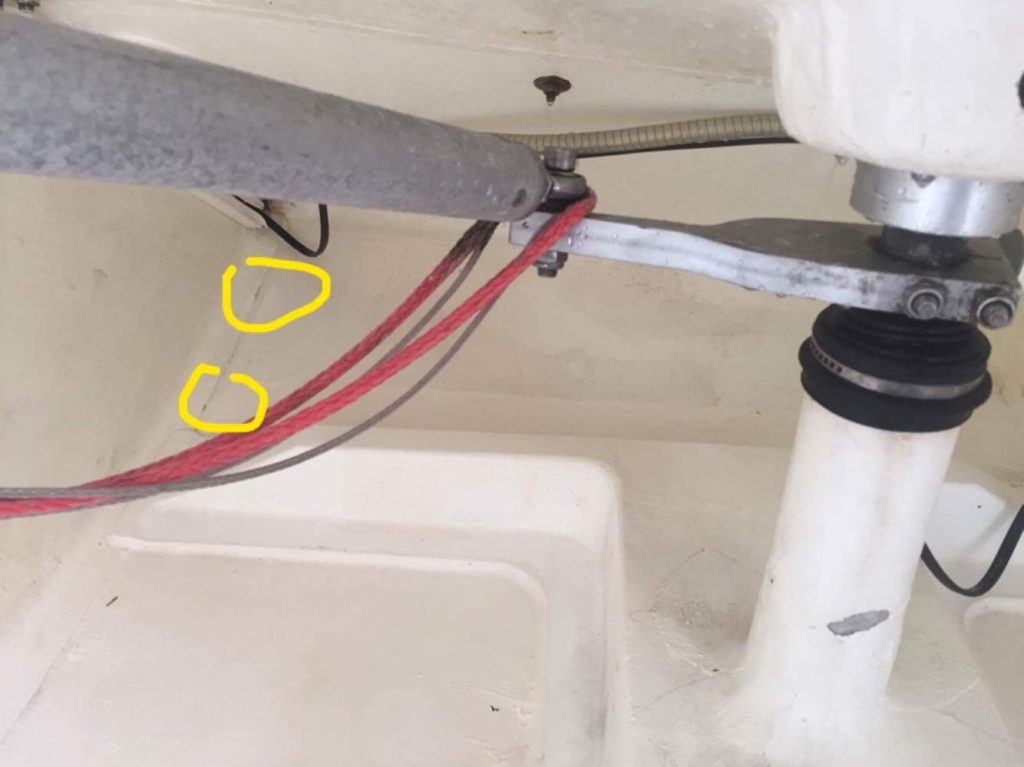This is a true story. The events depicted took place in Gran Canaria and Antigua between 2016-2017. At the request of the survivors, numbers have been left out. Out of respect for the lost money, the rest has been told exactly as it occurred.
In an ode to our most favorite crime TV shows, I write you a story of the Salt Water Massacre. A series of mysterious events that killed our World ARC plans, altered our Atlantic crossing, and threatened the future of Ocean Racers.
Hermes has been a sturdy boat. She was hauled out before purchase, thoroughly and professionally inspected. We unwittingly tested the fortitude of her rig during our first week out in the Mediterranean with lightening storms of 60+ knot winds. Sure December isn’t the best time to cross the Med, but this is beside the point.
Our problem? Water. Inside the boat. This can be understandable in wet and wild racing yachts, but it is a crime on a well protected and engineered Pogo racing-cruiser. This wasn’t just water down the hatch. This was water accumulating under the stove and the bed in the port aft cabin.
Buckets. At one point we emptied near 20 an hour. Our first days in the Atlantic were unwelcoming. With beam-on seas, strong winds, wet and cold conditions we couldn’t help but divert our course to Gran Canaria once the Atlantic’s threats became so serious.
Water was the worst when we were powered up. Is it our speed that is affecting it? Heeling angle?
While we didn’t know exactly why or how the water was coming in, we had suspicions. We figured out that the water under the bed was traveling through a gully that housed our butane gas line and the hot & cold water hoses for the galley.
So the water under the stove was connected to the water under the bed. We figured because the sink’s thru-hull was under the stove, this was our culprit. We also had water in the head and figured again, must be the thru-hulls.
We got hauled out at Rolnautic in Las Palmas de Gran Canaria to get them replaced. One of their guys came onboard and investigated the thru-hulls and concluded: not the thru-hulls. What?! We now had to solve a water problem on a dry boat. What could it be then?
The keel? It couldn’t be. Or we hoped it wouldn’t be… Hermes has a unique lifting keel that can retract on a hydraulic arm and reduce draft from 12 to 4 feet. The keel box is the center piece to the saloon, with hull braces and the mast built into it. This wouldn’t be just a complicated fix — we wouldn’t even know where to begin.
We thought this through seriously. Could it really be the keel? But the water was accumulating around the thru-hulls… And actually where the water was, it appears near impossible for the keel to be the cause.
We decided to ignore advice of Rolnautic and replace the thru-hulls as the initial quote was modest and their only other solution was a no-go in our book. Did I mention that we got pulled out the week leading to Christmas? And that in Spain there are three consecutive holidays: Christmas, New Year and Three Kings Day… Not to mention that whole siesta business…
So, you can imagine how long it took to get the work done. We were already behind schedule (supposed to be in Antigua for Christmas), but now it was looking like we might not even get there until February, which was a month past our ARC World Rally start date. The Water continued to kill hope, as we started 2017 just as unclearly as we closed 2016 — with a looming mystery over our heads.
We got back in the water right before Three Kings Day and went sail testing. The moment of truth. Nothing was more heart breaking than hearing Morgen shout F@#&! from down below while I was driving to keep us powered up. It was deflating, and salt was added to our wounds as the thru-hull replacement ended up being 3x what was initially quoted.
What could it be? Hauling us out again won’t help us solve the problem. We need to hawk this issue, watch every move to discover the source of all evil.
Morgen sponged out under the stove and in the gully under the bed, making it “bone dry.” He watched intensively and eventually discovered that the water was coming from the gully first, through the butane line that ran from the lazarette! As we stack our sails along the stern, the water that flows over the deck was having trouble exiting our otherwise open transom — so it began flooding the laz.
We rejoiced to have figured out the culprit with our own eyes, but mourned the lost funds and time as this likely would be a 12¢ glob of sikaflex job. We dried up the area, applied sikaflex, let it dry and then went out testing again.
“Dry as a bone,” Morgen reported from the companionway with a grin and a celebratory fist pump. This has now become his favorite phrase to describe our bilges. These words were so often uttered too soon as we falsely identified problems while over looking others. Nonetheless, we celebrated as our elations of victory trumped our financial losses.
But victory was short lived. As we tacked to test the other bilges, which had never been too much of a problem before, we discovered an ample amount of water has now pooled behind the nav seat. What?!
How? We resolved that these bilges are not connected to each other, so this cannot be residual water from the butane hose. This was a new problem.
We searched for another not-so-obvious obvious solution like the butane hose but on the starboard side, however this wasn’t as easy. The water had 2-3 entry points behind the nav seat: from the floor connecting to the head or a beam in the hull that rested just below that chine and housed all electrical cables running forward and aft. Either way, not good and not so easy to investigate. We eventually determined that the water was coming from the beam entry point, but how was it getting in there?
The keel? No. Please no. We had no other option but to take a look. We took apart the saloon table and a bunch of frustratingly placed bolts… just to find a solid keel box with nothing but a peep hole the size of a Pringles can. Not very helpful.
We called in back up, contacting Pogo Structures (our boat builder in France) to see if they could provide drawings and help solve this problem. They weren’t very helpful and kept asking if we were sure it wasn’t fresh, to the point when we just stopped consulting them due to a literal bad taste in our mouths.
We reviewed the facts. Heeled over = water. What happens when we are heeled over? Water over the deck. Deck vulnerabilities = stanchions.
So we ended up removing our black water tank in the head to reveal a rusty stanchion bolt and obvious signs of water dripping in. Could this be it? We poured a bucket of water over the deck and watched it drip in. Eureka! But it seemed too simple and too little amount to be our source.
Nonetheless we were hopeful, as we had basically run out of all other ideas. We made final preparations for our Atlantic crossing and prayed we had solved the Salt Water Massacre.
Our first day testing with the stanchion solution was our crossing departure day. We simply ran out of time and had to make moves. Our weather routing had us going right past Cape Verde, so if we still had major water problems we at least had an escape plan.
The first week was pleasantly uneventful. The bilges remained “dry as a bone” and we just stopped talking about it to begin the final stages of healing I guess. But right smack in the middle of the Atlantic, our past came back to haunt us.
Water behind the nav seat. Again?! What? How? What has changed?! Nothing!! Is this a joke?!
So: not thru-hulls, not head, not stanchion, nor fresh water… what is it?!
In our final act of brilliance (or desperation) as true detectives, we revisited the lazarette. Yes water was in there but upon visual inspection in port, we determined there was no obvious connection between the laz and starboard bilges. But we learned not to trust the obvious when it comes to salt water in boats.
So we went all CSI on the problem and came up with a plan. We cut open a red marker and dropped the ink pad in the laz. Low and behold just a short while later pink-hued water began to seep back under the nav seat. Nailed it!
Now that we knew the source of the water, we could rest easy knowing that the issue is manageable and not structurally threatening. We postponed further investigations of laz vulnerabilities and fixes until we got to port, because no one deserves to undergo that kind of torture at sea. We’ve suffered enough already.
Once we got to Antigua and recovered from our kitemare (24 blog coming soon), we cleared out the laz for a true crime scene investigation. Fuel jugs, diving gear, emergency water, spare anchor, survival suits, deck brushes… all out to examine every inch of the lazarette.
The laz was dry as a bone and completely clean. Again nothing appeared obvious. Any bolts or wires/tubes were watertight and not in anyway connected to the beam where the water was traveling. But what about this inch-long moldly bit in the seam of the hull? Could it be?
Morgen took the hose and began blasting water straight at this potential hairline crack. It took just moments before the water began flowing into the box area behind the nav seat. YES! WATER! WATER! WATER! I had never been happier to see water inside the boat, because this was the last time.
We hope.



Nice CSI work… So it was two 1″ areas of separation – is that a split of the fiberglass that makes up the lazarette or a two pieces of the lazarette that were joined and a seam that was originally sealed? What was the fix – simply to caulk over the crack or did you try to bond over the area?